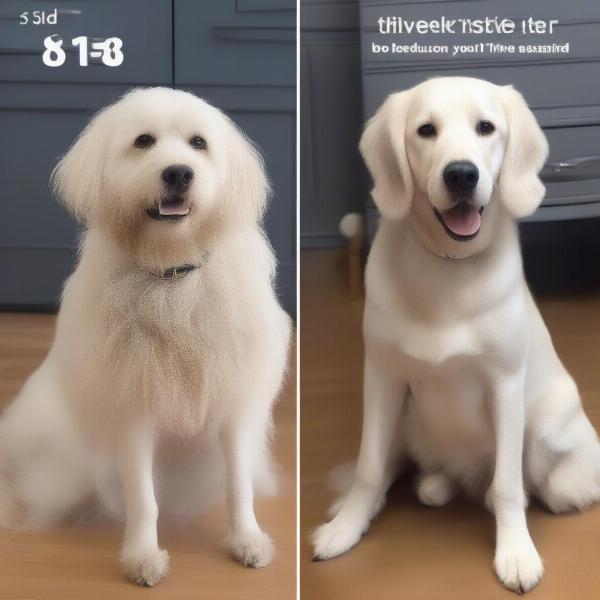An undercoat rake for dogs is a crucial tool for managing shedding, especially in double-coated breeds. It helps remove loose undercoat hair, preventing mats, tangles, and reducing the amount of fur floating around your home. This guide will cover everything you need to know about using an undercoat rake, from choosing the right one to achieving professional grooming results at home.
Choosing the Right Undercoat Rake
Not all undercoat rakes are created equal. Selecting the correct one depends on your dog’s breed, coat type, and size. Rakes with longer teeth are generally suitable for dogs with thick, double coats, while shorter teeth work well for dogs with finer hair. Consider the handle’s ergonomics too – a comfortable grip is essential for extended grooming sessions.
Types of Undercoat Rakes
- Long-toothed rakes: Ideal for thick, double-coated breeds like Huskies and Golden Retrievers. These rakes penetrate deep into the undercoat to remove loose hair effectively.
- Short-toothed rakes: Suitable for dogs with shorter, finer coats or sensitive skin. They are gentler and less likely to cause irritation.
- Universal rakes: Designed to work on a variety of coat types. A good starting point if you’re unsure which rake to choose.
Using an Undercoat Rake Effectively
Proper technique is key to maximizing the effectiveness of an undercoat rake and ensuring your dog’s comfort. Always brush in the direction of hair growth, using gentle, short strokes. Avoid applying too much pressure, which can irritate the skin. Start with small areas and gradually work your way across the entire body.
Step-by-Step Guide
- Brush your dog’s coat: Before using the undercoat rake, brush your dog’s coat with a regular brush to remove any tangles or mats. This will make using the rake more efficient and comfortable for your dog.
- Start with small areas: Begin with a small section of your dog’s body, such as the back or sides. Work in small, manageable areas to avoid overwhelming your dog.
- Use gentle strokes: Hold the rake at a slight angle to the skin and use gentle, short strokes in the direction of hair growth.
- Avoid sensitive areas: Be careful around sensitive areas such as the face, belly, and genitals. Use a gentler touch in these areas.
- Reward your dog: Make the grooming experience positive by offering treats and praise throughout the session. This will help your dog associate the rake with positive reinforcement.
Benefits of Using an Undercoat Rake
 Benefits of Using an Undercoat Rake
Benefits of Using an Undercoat Rake
Using an undercoat rake regularly offers numerous benefits for both you and your dog. It minimizes shedding, prevents mats and tangles, promotes healthy skin and coat, and reduces the risk of skin infections.
“Regular use of an undercoat rake can significantly reduce shedding and improve the overall health and appearance of your dog’s coat,” says Dr. Emily Carter, a veterinarian specializing in canine dermatology. “It’s a valuable tool for any dog owner, especially those with double-coated breeds.”
Maintaining Your Undercoat Rake
Cleaning your undercoat rake is essential to maintain its effectiveness and prevent the spread of bacteria. After each use, remove the collected hair from the rake. Wash the rake with warm, soapy water and dry it thoroughly.
“A clean undercoat rake is a crucial part of maintaining your dog’s hygiene,” advises Sarah Miller, a professional dog groomer with over 15 years of experience. “Regular cleaning ensures the rake remains effective and prevents the buildup of dirt and bacteria.”
Conclusion
An undercoat rake is a must-have tool for managing shedding and promoting a healthy coat for your dog. By choosing the right rake and using it correctly, you can significantly reduce the amount of fur in your home and keep your dog’s coat looking its best. Investing in a quality undercoat rake and establishing a regular grooming routine will pay dividends in a cleaner, healthier, and happier home for both you and your furry friend.
FAQ
- How often should I use an undercoat rake on my dog? This depends on your dog’s breed and shedding pattern. Generally, once or twice a week is sufficient for most dogs.
- Can I use an undercoat rake on a puppy? Yes, but be extra gentle and use a rake designed for puppies or dogs with sensitive skin.
- What’s the difference between an undercoat rake and a deshedder? Both tools remove loose hair, but an undercoat rake focuses on the undercoat, while a deshedder targets the topcoat. They can be used in combination for optimal results.
- My dog doesn’t like being brushed. What can I do? Start slowly and make the experience positive with treats and praise. yummy combs for dogs can help.
- Can I use an undercoat rake on all dog breeds? While generally safe for most breeds, consult a groomer or vet for advice on specific breeds or skin conditions. combs dog or moulting brush for dogs may be more suitable for some breeds.
- How do I clean my undercoat rake? Remove hair after each use, wash with warm soapy water, and dry thoroughly.
- Where can I buy a quality undercoat rake? Pet stores, online retailers, and even some veterinary clinics carry undercoat rakes. deshedder tool for dogs and dog undercoat rake can be found online.
ILM Dog is your one-stop resource for expert advice on dog care, breeds, health, training, nutrition, grooming, and much more. We offer comprehensive guides and practical tips to help you provide the best possible care for your canine companion. For professional guidance tailored to your dog’s specific needs, contact us today! Email: [email protected], Phone: +44 20-3965-8624. Visit ILM Dog for a wealth of information to support your dog’s well-being, from puppyhood to senior years.